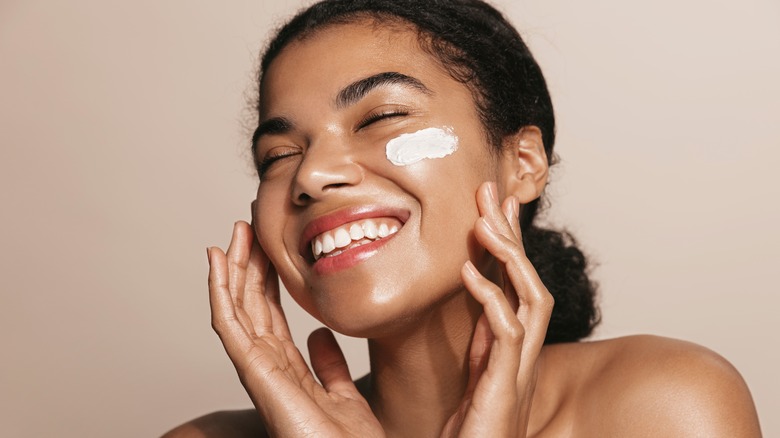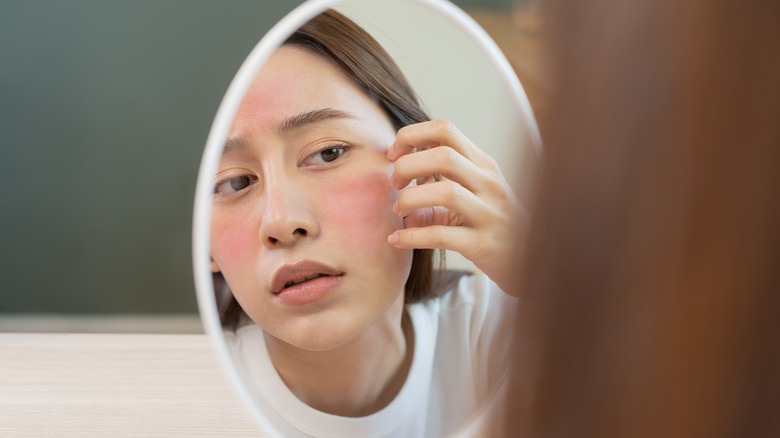Strengthening Your Skin Barrier Can Protect Against Winter Windburn
We may receive a commission on purchases made from links.
With more weeks of winter on the horizon and an increasingly unstable climate, cold weather isn't going away anytime soon. The bitter temperature brings about a host of skin issues such as eczema, dry, flaky patches, and itchiness, says NewYork-Presbyterian. Aside from the usual winter skin woes, the cold, dry air can also wreak damage to the surface of your skin. While a damaged skin barrier is typically associated with too much exfoliation or a bad reaction to retinol, chilly air can also cause the skin barrier to deteriorate.
This is due to a phenomenon known as windburn. The sunburn of the colder months, windburn occurs when the cold wind and lack of humidity deplete the oils in your face, drying out the skin and increasing sensitivity (via Healthline). If you're already using products formulated to remove and renew layers of the skin — like chemical exfoliants and retinoids — your skin could have a more serious reaction to the harshness of freezing temperatures, opening up the possibility of irritated, inflamed skin.
How to prevent a damaged skin barrier from windburn
The first key to preventing windburn is bundling up. Ensure your skin is protected against the cold by wearing hats, gloves, and thick coats. Rather than simply tossing a scarf around your neck, let it cover the bottom half of your face for more precaution (via Health).
When you notice the cold weather making your skin a bit more sensitive, stop using products that can potentially damage your skin barrier. You'll want to use gentle ingredients on your skin that focus on hydration. Using thick, emollient products will create a barrier on any exposed skin from the cold.
Adapting the skin flooding method may help prevent moisture loss if you struggle with dry skin. By creating a layered moisture sandwich by adding a spritz of a hydrating mist between your serum, moisturizer, and occlusive or oil, your hydrating products may absorb better. The key to locking in moisture is by using a moisturizer that will keep everything sealed in. The Cerave Moisturizing Cream is a rich and hydrating cream that can be used on the face and body. Made with three ceramides and hyaluronic acid, this moisturizer can revive even the driest, flakiest skin.
Additionally, wearing sunscreen in the winter is still a priority despite freezing temperatures and cloudy skies. According to the Skin Cancer Foundation, not only can UV rays penetrate through clouds, but they reflect off of snow, giving your skin a double dose of UV light.
How to heal a damaged skin barrier
Our skin barrier, the outermost part of the skin, protects it from outside threats and helps keep moisture locked in. When it's damaged, it can look and feel like a multitude of things — the primary feeling, however, is irritation. Even if your skin doesn't appear red or inflamed, it can produce a burning sensation when products are applied, become itchy and flaky, break out, or have dry patches (via Cleveland Clinic). When you notice your skin barrier is damaged, it's time to strip down your skincare routine to the basics.
A routine that babies your skin with hydration and mild products is key. Wash with lukewarm water and a gentle cleanser such as the La Roche Posay Toleriane Hydrating Gentle Cleanser. Paraben, sulfate, fragrance, and oil-free, this La Roche Posay cleanser offers a deep yet mild cleansing for sensitive skin. Formulated with spring water and niacinamide, it hydrates and attends to irritated skin.
To speed up the repair of your skin barrier, try the cocokind Ceramide Barrier Serum. With five ceramides and lipids, this serum was created to mirror the skin barrier itself, healing and repairing it. Incorporating aloe vera leaf juice and glycerin, it hydrates and draws water into the skin, locking moisture in for faster healing.


